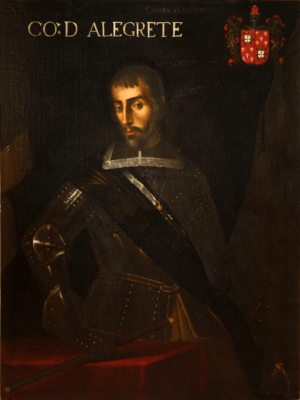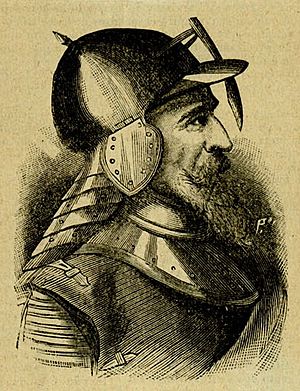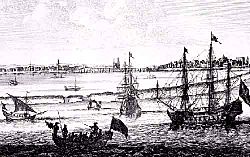Matias de Albuquerque, Count of Alegrete facts for kids
Quick facts for kids
His Lordship
The Count of Alegrete
|
|
|---|---|

The Count of Alegrete by Feliciano de Almeida (1673-5), in the Uffizi Gallery, Florence
|
|
| Governor General of Brazil | |
| In office 1624–1627 |
|
| Monarch | Philip III of Portugal |
| Preceded by | Diogo de Mendonça Furtado |
| Succeeded by | Diogo Luís de Oliveira |
| Loco Tenente (Governor) of Pernambuco | |
| In office 1620–1627 |
|
| Monarch | Philip II of Portugal Philip III of Portugal |
| Preceded by | Martim de Sousa Sampaio |
| Succeeded by | Luis de Rojas y Borja, Duque de Ganja |
| Personal details | |
| Born |
Paulo de Albuquerque
c. 1580 Olinda, Portuguese colony of Brazil |
| Died | 1647 Lisbon, Kingdom of Portugal |
| Military service | |
| Allegiance | Portuguese Empire |
| Branch/service | Army |
| Rank | General |
| Battles/wars | Dutch-Portuguese War Portuguese Restoration War |
Matias de Albuquerque was a brave Portuguese leader and soldier. He was born in the 1580s in Olinda, a Portuguese colony in Brazil. He passed away in Lisbon, Portugal, on June 9, 1647. Matias was known as the first and only Count of Alegrete.
People called him the "Hero of Two Continents." This was because he fought bravely against Dutch invaders in colonial Brazil starting in 1624. Later, in 1641, he became a general in Portugal. He fought for King John IV during the Portuguese Restoration War. Matias won the battle of Montijo against the Spanish in 1644. For this important victory, the king gave him the title of Count of Alegrete.
Matias was the youngest son of Jorge de Albuquerque Coelho. His birth name was Paulo de Albuquerque. He later changed it to Matias to honor his relative and godfather, Matias de Albuquerque, who was a very important leader in India.
Contents
Matias's Early Career
Matias's brother, Duarte de Albuquerque Coelho, was in charge of the Pernambuco colony in Brazil. This was part of a system called "hereditary captaincies." These were special areas given by the Portuguese king to noble families to manage. Matias was born in Olinda, a town in Pernambuco. When he was young, he moved to Rio de Janeiro to become a soldier.
Leading Pernambuco
Matias spent three years serving in North Africa. In 1620, his brother Duarte asked him to help govern Pernambuco. Matias worked hard to bring his family's influence back to the colony. They had been away from direct rule for almost 50 years. He became the lieutenant-governor on May 20, 1620. He immediately started making the defenses of Pernambuco stronger. He stayed in this role until November 1627.
The next year, Brazil was so big that the king divided it into two main areas. King Philip II created the State of Brazil, with Salvador as its capital. To the north was the State of Maranhão, with its capital at São Luís. Pernambuco was a part of the State of Brazil.
Fighting the Dutch Invaders
In 1624 and 1625, the Dutch attacked the colony of Brazil. They quickly took over Salvador, the capital of the State of Brazil. They even captured the governor-general, Diogo de Mendonça Furtado. When other Portuguese leaders in Brazil heard that Mendonça was sent to prison in the Netherlands, they met. They chose Albuquerque to be the temporary governor-general of Brazil.
After Salvador fell, Portuguese soldiers fought back. Bishop Marcos Teixeira gathered about 2,000 men. Later, Captain Francisco Rolim de Moura also led fighters. They constantly bothered the Dutch, keeping them mostly inside Salvador.
When Albuquerque heard he was appointed governor, he first wanted to march to Salvador. But he was told to wait for the right moment. From his base in Olinda, he sent troops to help the Portuguese fighters. These fighters were based at Arraial do Rio Vermelho and Recôncavo. The next year, an experienced leader, Diogo Luis de Oliveira, became the permanent governor-general.
The Dutch did not hold Salvador for long. At this time, Spain and Portugal were ruled by the same king. The Spanish knew about Salvador's capture a month before the Dutch did. A large rescue fleet was quickly put together. The Dutch West India Company knew this fleet was coming. But bad weather stopped their own ships from helping Salvador. They thought they could hold out, but they were wrong. A Spanish-Portuguese fleet of 52 ships arrived on March 30, 1625. It was led by Don Fadrique de Toledo. After a month-long siege, the Dutch had to give up the city on April 30, 1625. The Spanish-Portuguese allowed the Dutch soldiers and their ships to leave Salvador.
Albuquerque was called to Madrid, Spain, to talk with the king's advisors. There were rumors that the Dutch planned another big invasion of Brazil. As a result, Albuquerque was made the head of fortifications and inspector-general for the northern areas of Brazil. However, Spain was busy fighting the Thirty Years' War in Europe. More money and soldiers were sent to Europe and to protect the gold and silver colonies. Albuquerque returned to South America in 1629 with very little help. He had some silver coins and only 27 Portuguese soldiers for Brazil's defense.
The Second Dutch Invasion
In February 1630, the Dutch invasion finally happened. They quickly took over Olinda and its port, Recife. Albuquerque and his smaller army had to retreat. But before they left, they burned the sugar warehouses at Recife. This stopped the Dutch West India Company from using them and taking the valuable sugar.
Albuquerque then set up a new defense. He chose a high, strong position called Arraial Velho do Bom Jesus. This spot was between Olinda and Recife. It was easy to defend and mostly kept the Dutch trapped inside the towns. Albuquerque held this position until 1635, even though the Dutch attacked Arraial many times.
Calabar's Role
Some of the attacks on Arraial were planned by a man named Domingos Fernandes Calabar. He was a mixed-race man born in Porto Calvo, which was then part of Pernambuco. Before a peace agreement between Portugal and the Netherlands ended in 1621, Dutch traders often visited Brazilian ports. Calabar had used these contacts to get a job with the Dutch West Indies Company in the Netherlands.
When Portugal and the Dutch had problems in 1624 because of the capture of Salvador, Calabar was in a difficult spot. He felt pulled between his birthplace and his job. By 1630, he was back in Recife. His knowledge of the local area made him very valuable. The Dutch knew the rivers and swamps along the coast. But they knew almost nothing about the land further inland. Calabar, as a merchant and smuggler, knew every path. He had an amazing understanding of the local landscape.
In April 1632, Calabar offered to help the Dutch. He quickly showed he was very good at planning surprise attacks. Albuquerque and the other Portuguese leaders learned about Calabar. Because of his many successes, he became known for being very clever and also for being a traitor.
After some time, the Dutch decided to leave Olinda. They burned it down and focused all their efforts on Recife.
See also
 In Spanish: Matias de Albuquerque para niños
In Spanish: Matias de Albuquerque para niños




